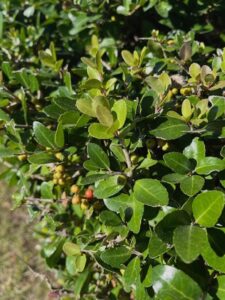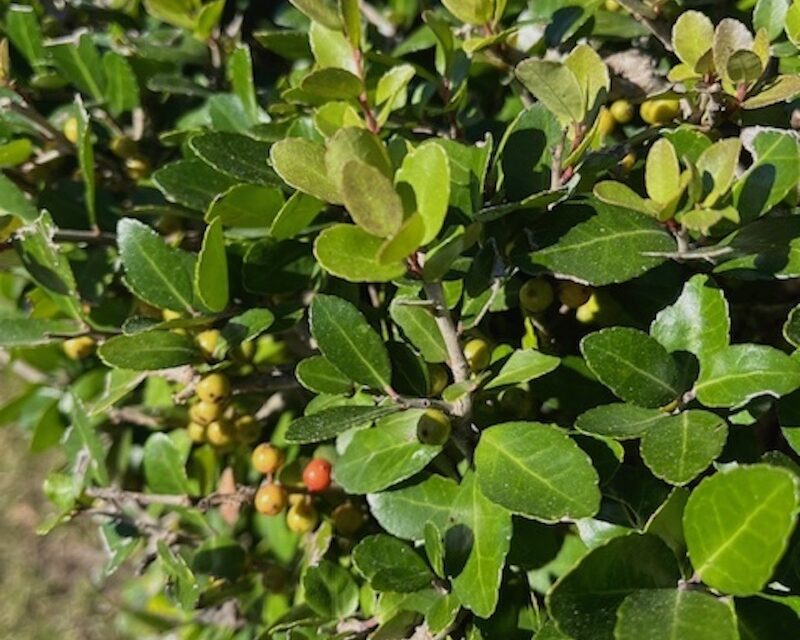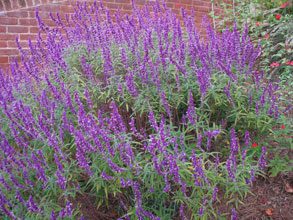
Yaupon berries
Yaupon holly is native to South Carolina as well as other states in the American South. You have seen it a hundred times growing along the road or marsh even if you did not know its name. It has small shiny dark green leaves and the female plants have small red berries in the winter. It can be tall and skinny, weeping, or dwarf and rounded. It is considered a perfect landscape plant because it is evergreen and very tough. Hurricanes, hard freezes, drought, floods – nothing seems to affect this hardy shrub. You may very well have a variety in your yard.
Yaupon, though, is more than a pretty face and a robust plant. The leaves can be made into a tea.It is the only naturally caffeinated plant in America. Native Americans used this tea as a restorative and believed that it gave them strength and vigor. The leaves were picked, roasted over an open fire, and then boiled in water. Yaupon has dozens of vitamins, minerals, amino acids, polyphenols and antioxidants which are said to fortify the body and calm the mind.
Yaupon tea was also used in purification ceremonies. The earliest use of yaupon tea can be traced back to the Cahokia Mounds in Illinois where tea residue was found inside a ceramic vessel that dated to 1050 C.E. Early descriptions of Yaupon tea were told by explorers such as Cabeza de Vaca while he was discovering the coast of Texas in 1542. The Spanish referred to the tea as the “Black Drink” due to its dark color and they came to consume large quantities in their colonies.Colonists observed Native tribes using this tea in a men–only purification ritual. It was believed that consuming the tea in large quantities lead to a clarity of mind.
As North American became populated by European settlers, yaupon tea was grown for domestic consumption. It was also exported to London and sold as South Seas Tea. It Paris it was called Apalacine and served in salons of the aristocratic class. By the 1780’s, yaupon tea had become so popular that the British East India Company decided that it was a threat to their market of teas from Asia. Thus began a smear campaign against this North American product. In 1789, the first superintendent of the Royal Botanic Gardens at Kew gave yaupon its scientific name, Ilex vomitoria. The word was spread that this tea could cause vomiting and other unwanted side effects even though there was no proof of this.
The campaign worked and by the mid 1800’s, yaupon holly tea’s popularity and use became nearly nonexistent. It did not help its image that it was only still in use among poor, rural areas where they could not afford the luxury of imported tea.
Today yaupon tea has not only been rediscovered, but looks to become a $81.6 billion dollar industry by 2026. How did this happen? We owe this to two people- Texas native Abianne Falla and Floridian Bryon White. After a devastating drought, Falla discovered that the only plant on her family’s farm that seemed to survive and remain healthy was yaupon holly. White also discovered that yaupon holly thrived while hiking through the coastal forests near his home.They both independently researched this “miracle” plant and discovered its unique history. Both now own yaupon tea companies and the numbers of new companies is growing. This plant thatwas maligned in a political slander is now reaching many people as a popular beverage.
In 2018, the American Yaupon Association was initiated to connect yaupon growers as well as consumers. It also is dedicated to ensuring that growers will honor yaupon’s past in an ethical and sustainable way. It is important also to recognize the indigenous roots of this product as part of our heritage.
What does the tea taste like? I ordered some to try and it is not unpleasant. It has a woody, earthy flavor and I would definitely drink it again. I cannot say that I felt like stalking a deer or plowing a field after I drank it, but it did have a little zing to it.
As well as providing a source for America’s only native tea, yaupon is a great landscape plant. I have three dwarf yaupons at the side of my driveway that have been driven over by trucks several times and they bounce right back. I have pruned them once in ten years. The wild varieties tend to be leggy, but you can cut them into any shape. Yaupons are often recommended as a buffer along the marsh to prevent erosion. The weeping variety is particularly attractive and grows around 20 feet high. The red berries in the late fall are nice pop of color. Do not bring them in the house for a decoration. Unlike other hollies, they fall off immediately and roll everywhere. Leave them on the bush for the birds to enjoy and they will help spread more of this great native shrub which not only looks nice, but makes a pretty decent cup of tea.









